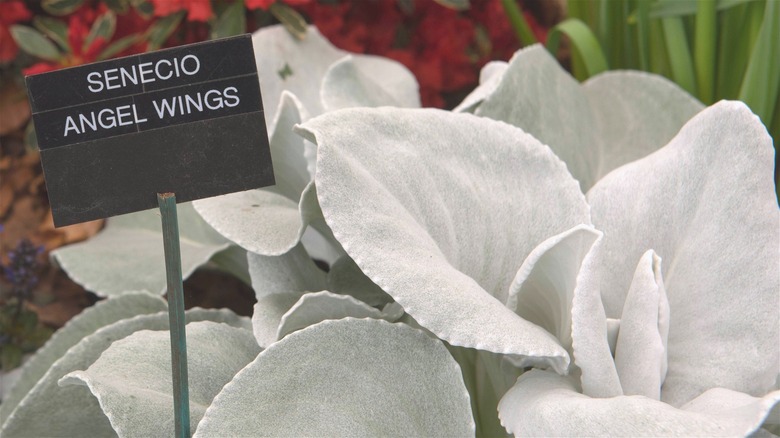How To Grow And Care For A Gorgeous Angel Wings Plant
Thriller, spiller, filler. It's the simple formula you should use when designing a container garden. You combine plant species that fit into these categories to create a cohesive planter arrangement. While few plants fit all three categories, Angel Wings (Senecio candidans 'Senaw') is an exception, doing double, even triple duty. With its big, silver-white leaves that feel like velvet to the touch, this drought-hardy cultivar mounds-up quickly in the center of a pot (your thriller) or flops dramatically over the sides (your spiller). It can also work as a filler in garden beds. There's a bit of a catch — Angel Wings can be notoriously fickle. Even the most passionate, experienced indoor and outdoor gardeners might struggle to keep their plants alive. To increase your chances, plant Angel Wings in well-draining soil, let it dry out between waterings, trim dead leaves, keep an eye out for rust, and fertilize once a year in spring.
The common name "Angel Wings" stems from the fact that its leaves resemble those of heavenly beings, though some liken its foliage to a flock of startled doves taking flight. Other common names are sea cabbage and shining-white ragwort. The plant's scientific name may be a little confusing. Senecio candicans 'Senaw' was developed in Chile, derived from species found growing in the sandy dunes of the Falkland Island and southern South America. However, Senecio candicans — minus the 'Senaw' — is a different species native to India.
Add drama and texture outdoors with silver-hued Angel Wings
The genus Senecio contains lots of weird and wonderful succulent species. If you know how to grow and take care of a dusty miller plant (Senecio cineraria), you'll likely have success with Angel Wings. Like its other Senecio cousins, Angel Wings thrives in the USDA hardiness zones 8 to 11 as a perennial; it needs to be treated as an annual or overwintered indoors in cooler regions. It's drought-tolerant, salt-tolerant, and even fire-resistant (those silver-gray leaves repel the sun's harshest rays), and pests of the mammalian variety leave it mostly alone. Be warned: the plant can cause health problems in cats and dogs who decide to nibble on its fluffy foliage. In fact, the entire Senecio genus is poisonous to pets and grazing animals.
A star among the velvety flowers and plants that'll add a hint of luxury to your garden, budding designers can incorporate Angel Wings almost anywhere. Outside, add it to a xeriscape garden or pathway borders, fill rock garden crevices, or provide textural contrast to a cottage garden. Plant it around tall potted shrubs to hide ugly stems or soften a geometric succulent and cacti arrangement. Visually, this vibrant plant is at its most dramatic when planted with dark or single-hued foliage. 'Tis the season? Combine Angel Wings with bright red poinsettias for a highly festive indoor arrangement. Be sure to only plant Angel Wings in a garden bed as a perennial if you never get frosts; keep in mind, too, that it well exceeds a foot in height and the same in breadth when mature.
Timing and location are important care factors
Since Angel Wings is used as an annual in many parts of the U.S., it's best to peruse local or online nurseries in late spring or early summer. That's when the plants are most readily available to home gardeners. Nurseries in warmer climates may sell these potted plants all year round. It's important not to flood your Angel Wings, especially young seedlings. Gently water your wilted seedlings every five minutes until they're perky. Keep them damp, too, if you can't plant them right away. Angel Wings does best in free-draining, loamy, and sandy soil. Overly fertile soil makes it grow leggy and too much water may cause root rot. If container gardening, pop it in a planter with one or more drainage holes.
Choose a spot, indoors or out, in full sun to part shade — somewhere in between is best for immature plants, just make sure there's absolutely no chance of frost if you're planting Angel Wings outdoors. Once in the ground or a pot, Angel Wings care is relatively straightforward. Trim off old leaves and deadhead the yellow, button-like flowers, if you get any. Water the soil only; damp leaves lose their fluffy appearance. Apply fertilizer in spring and apply a broad spectrum fungicide monthly if you suspect rust or honey fungus, two diseases Angel Wings can be susceptible to. In the winter — or generally, in damp climates — allow the plant to dry completely before its next watering.


